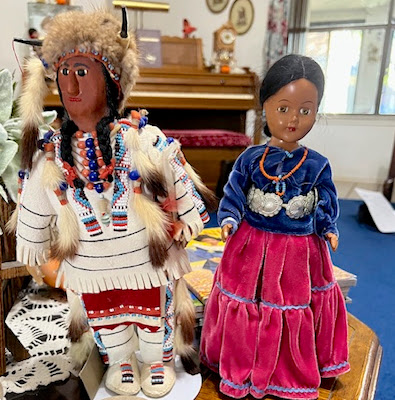In keeping with the upcoming Thanksgiving holiday, many members brought dolls representing Native Americans. This papoose in a pink felt cradleboard belongs to member Myrna Loesch. The cold-painted bisque baby was dressed by Madame Hendren, which was part of the part of the Averill Manufacturing Corporation, and dates from 1916 through the 1920s. Myrna said that a handwritten note found with the doll read, "In Lucy Brown's keepsake box packed up in Pittsburgh 1927."
Member Elaine Jackson brought two pairs of cloth dolls to illustrate the myth of the First Thanksgiving at Plymouth Massachusetts in 1621. The first pair, representing Priscilla Mullins and John Standish, appeared earlier on this blog. The dolls, dating around 1950, have pressed and painted faces and are from Just Folks Doll House by Helen Walker of Staunton, Virginia.
The second pair were a Native American boy and girl, made by the Michigan WPA Toy Project, sponsored by Michigan State College. Dating around 1939, the dolls were made using the Edith Flack Ackley cloth doll pattern. They are have painted features, rather than the embroidered features used for the Ackley pattern and are all original. Elaine noted that the dolls' costumes are not representative of the Wampanoag Tribe (who also called themselves the People of the First Light), who were the indigenous people who greeted the Pilgrims.
Member Sylvia McDonald, who was the hostess for the meeting, shared several Native American dolls. The man in the elaborately beaded buckskin outfit represents a Plains Indian. Sylvia said that he appears to be of either carved wood or treated cloth and came with a tag denoting him as, “Circa 1930’s.” The woman doll was purchased for her by her brothers, John and Larry, in Taos at a shop in 1954 or 1955. Of hard plastic, she is dressed in a traditional Navajo costume.
This homemade cloth Indian family were sewn made by a friend’s niece when Sylvia was around eight or nine years old. She said that they were some of the first dolls that she considered a part of her collection.
This trio belongs to Member Bette Birdsong. The woman wearing a navy wool dress, which was typical of her tribe, and the man on the right, are reproductions of dolls made by the Crow. The doll with the heavily beaded bodice, which was characteristic of the Sioux, is an antique. The beadwork includes tiny images of American flags.
Member Jenell Howell brought a complete set of composition Snow White and the Seven Dwarfs dolls in what appears to be their original presentation box. These dolls were issued by the Knickerbocker Toy Company to coincide with the 1937 release of Disney's first animated feature. All of the dolls are in excellent condition and Jenell said that there was speculation is that this set might have been a salesman's sample.
Returning to a seasonal theme, Member Jan Irsfeld displayed two Madame Alexander Cissy dolls from a series issued over four years, starting 2005. The dolls were inspired by the Pompadour period, when French fashion was an its height, and the dolls were dressed in clothing representing the four seasons. This pair represents Fall and Jan made the man's knee-high suede hunting boots.
Another example of Jan's terrific tailoring and dazzling beading skills.
Member Nancy Countryman shared this 17-inch tall composition doll. The doll has sleeping blue eyes and two teeth, but no markings.
She also brought a homemade cloth gray mouse dressed in fall colors. A clear glass mason jar serves as this doll's body.
Member Pam Hardy brought these miniature porcelain Yolanda Bello dolls from the Picture Perfect Babies Collection by The Ashton Drake Galleries. The boy dressed in a baseball outfit is Matthew and the girl’s name is Jennifer.



















